Its name is the French name of Lake Geneva (Lac Léman). Sputnik modified by Don Lopp.

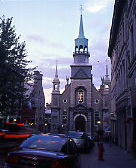
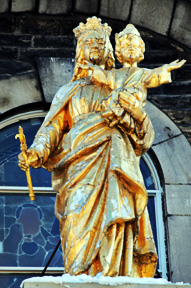 In old Montreal, photographed using two Mamiya C-330 cameras with 65 mm. lenses on a Manfrotto tripod. I used a twin cable release to trip the shutters in near synch. Notre-Dame-de-Bon-Secours (“Our Lady of Good Help”) Chapel, a church in the district of Old Montreal. One of the oldest churches in Montreal, it was built in 1771 over the ruins of an earlier chapel. In 1849, Mgr. Ignace Bourget, Bishop of Montreal, gave the chapel a statue of the Virgin as Star of the Sea, which was placed atop the church overlooking the harbor. In the 19th century, the chapel came to be a pilgrimage site for the sailors who arrived in the Old Port of Montreal; they would make offerings to the Virgin in gratitude for her “good help” for safe sea voyages.
In old Montreal, photographed using two Mamiya C-330 cameras with 65 mm. lenses on a Manfrotto tripod. I used a twin cable release to trip the shutters in near synch. Notre-Dame-de-Bon-Secours (“Our Lady of Good Help”) Chapel, a church in the district of Old Montreal. One of the oldest churches in Montreal, it was built in 1771 over the ruins of an earlier chapel. In 1849, Mgr. Ignace Bourget, Bishop of Montreal, gave the chapel a statue of the Virgin as Star of the Sea, which was placed atop the church overlooking the harbor. In the 19th century, the chapel came to be a pilgrimage site for the sailors who arrived in the Old Port of Montreal; they would make offerings to the Virgin in gratitude for her “good help” for safe sea voyages.
The close-up on this page was taken with a NikonD300 with a 55-200 mm VR lens. f-8 200 mm 1/250 sec.
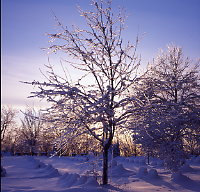 I noticed Dale Walsh also likes photographing in Mount Royal Cemetery, an oasis of calm in the middle of Montreal. Freezing rain covered the trees with ice and then a snow storm blanketed the tombstones. I like the way the trunk hides the sun in the left image, but it peeks out in the right image.
I noticed Dale Walsh also likes photographing in Mount Royal Cemetery, an oasis of calm in the middle of Montreal. Freezing rain covered the trees with ice and then a snow storm blanketed the tombstones. I like the way the trunk hides the sun in the left image, but it peeks out in the right image.
Original slide shot December 14, 2008 with a tripod-mounted Heidoscop with Provia 100P at 1/50th at f22.
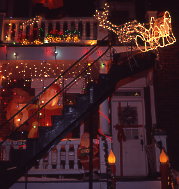 Wrought iron staircases are typical of Montreal, and I like the way Santa parked his sleigh on the top of the wrought iron staircase in this tableau.
Wrought iron staircases are typical of Montreal, and I like the way Santa parked his sleigh on the top of the wrought iron staircase in this tableau.
Original slide shot December 13, 2008 with a tripod-mounted Heidoscop on Provia 400X exposed for 2 seconds at f22 with fill flash.
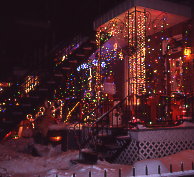 Most of the homes in Verdun are simple brick rowhouses that all look much the same. With limited opportunity for originality in the architecture of the home, the people of Verdun go wild decorating their homes at Xmas and Halloween.
Most of the homes in Verdun are simple brick rowhouses that all look much the same. With limited opportunity for originality in the architecture of the home, the people of Verdun go wild decorating their homes at Xmas and Halloween.
Original image shot December 13, 2008 with a tripod-mounted Heidoscop on Provia 400X exposed for 2.5 seconds at f22 with some fill flash. (There is no flash sync on the Heidoscop so I just set off the flash during the long exposure.)
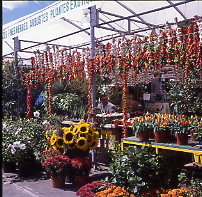
Original slide, taken August 31, 2008 with tripod mounted Heidoscop on Provia 100F at 1/20 at f25.
While I know that all four of my images in the last loop from the Mendenhall Glacier, it is where my camera has most frequently been pointed in the past year. Experiencing the changing ice and witnessing the emergence of fresh ground is thrilling.
Back in June of 2007, I stood in the middle of a stream which had torn a hole in the side of the ice. The water was disappearing into the darkness under the glacier as it ran out to the lake. It was a bit disconcerting to make my way down the rock-face so I could stand in the stream of snow-melt and make the image. It would have been a wet, hypothermic climb had I been knocked down and over the edge 😛
A little over a year later, I stood in the same stream and was stunned by the change. I attempted another image from the same location as before, but found the composition totally boring. Instead, I brought the camera forward about eight feet. This was still in the stream, but my tripod had better footing and the composition had some foregound interest and receding lines. By chance, a rock from the earlier image is present in the lower right of the later image. It helps give an idea of how much has changed.
The first image was shot with my TL120-1 while the second was shot with my wide-angle TL120-55. Both cameras were tripod mounted.
Both images are mounted in 46x52mm (MFW) mounts from Rocky Mountain Memories. I really like the mount. The aperture is 2mm wider and 6mm taller than the normal 40×50 (MFL) mount. Give them a try if you can get your hands on any.
As my previous submission to the folio demonstrate, I have been exploring the freshly exposed ground left by the retreating Mendenhall glacier. What I find are features, shapes, textures and colors which have been exposed to us for no more than ten years. In some cases, the rock has exposed in the previous month and my feet and hands are some of the first things to touch the surface since the ice left.
This is a texture, shape and color study. I am fascinated by the sparkling mica and quartz, the conflicting contour lines and rock layers, and by the macro-scopically smooth shapes which closer study shows to be an extremely rough surface.
It was shot with my TL120-1 (so 80mm lenses) which was tripod mounted. I made exactly one exposure, but I’m pleased enough with the results that I want to make more.
The Steamship Wharf in downtown Juneau has sufficient capacity to moor three cruise ships. When the dock is full, others must anchor in the channel and lighter their passengers in. When the ships are able to tie up, they tower over the library (which is immediately adjacent to the wharf); these are big. Depending on the ship, they may use six, seven or eight hawsers to secure themselves to the dock. Each of these lines is continually monitored by the ship-board watch and let out or tightened to accommodate the motion of the boat and the tide.
I really like the way the lines radiate out to the ship and disappear into the hull openings. For a couple of years I was able to make these images and I was starting to figure out what it would take to get everything in focus and have a good composition. Then “they” rammed a couple of planes into a pair of skyscrapers on the other side of the globe and the Department of Homeland Hysterics took over our docks. The consequence is that I can no longer get close enough to the lines to again attempt this image. Yes, the foreground is soft, but that’s the way it’s gonna be 🙁
Tripod mounted Sputnik, Provia 100F
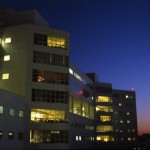 Shot in natural evening light using twin Hasselblads with 75mm lenses.
Shot in natural evening light using twin Hasselblads with 75mm lenses.
I had set up the twin rig Hassys but one of them was acting funny, making a nasty noise advancing the film (they have electric/motor drive film advance). Just to be safe, between exposures I shifted the tripod over 9-12 inches each time. I figured if the film advance was screwed up (it was) I’d have some side-steps on at least the one roll. And that’s how I “succeeded” in my photography that night. The careful observer will be able to make out the Orion Nebula in this shot, as well as read the time of day in a distant wall clock!
12″ (?) interaxial original slide shot in 2004. f/11? five to ten seconds exposure, if I remember correctly.
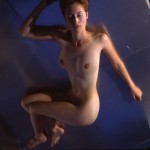 Terri had to hold very still, while I manually wound the film and shifted the camera. You can see some rivalry near her adams apple and eyes. I shot the picture “upside down” and wanted her to appear to be flying like an angel (but asleep and dreaming too, go figure). This is some of my early MF3d, from 2001, using a borrowed TLR
Terri had to hold very still, while I manually wound the film and shifted the camera. You can see some rivalry near her adams apple and eyes. I shot the picture “upside down” and wanted her to appear to be flying like an angel (but asleep and dreaming too, go figure). This is some of my early MF3d, from 2001, using a borrowed TLR
Shot sequentially with twin a TLR Rolleiflex on a slide bar. f22? Exposure with flash in studio. Original slide.
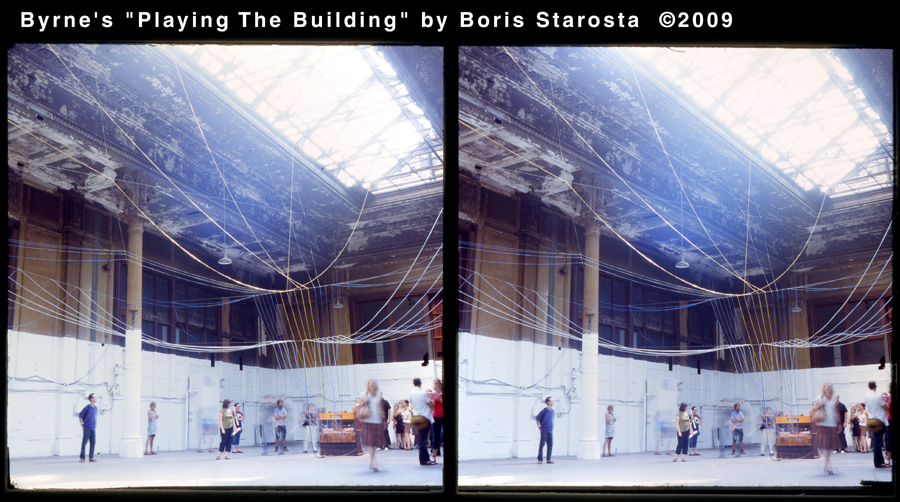
David Byrne rigged up this industrial space in NYC with numerous actuators – hammers, motors and similar vibration inducing devices – attached to columns, radiators, roof trusses, etc. Visitors to the installation can sit down at the old organ keyboard, where from they “play the building”. The music/sounds thus created, in combination with the space are very mesmerizing. I was there on two occasions. Once nearly empty (I got to play!), the second time with Spud, very crowded. The effect was different each time, interesting both times.
Above: Fuji RXP, f11 (?), 1-2 sec. exposure in available light, using Sputnik, 80mm lenses.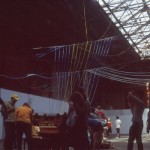
This is the original slide shot in summer of 2008.
The organ was modified to send signals via electric or pneumatic lines to the various actuators. The music was essentially percussive: lots of clinks and clanks. Only the electric motors near the ceiling, in the trusswork under the skylight, produced “tone” – a dark, rumbling, droning tone.
Right: Fuji RXP, f11 (?), 1/8 sec. Exposure in available light, using Sputnik, 80mm lenses. This is the original slide.
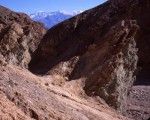 Golden Canyon is located on the central east side of Death Valley. My first shot (provia 100f with a Rolleidoscop 100th f11/16) is looking back from Golden Canyon at the mountains on the west side of the Valley. There are many good hikes with wonderful opportunities for stereo photography in Death Valley but you need to be in the right place at the right time for the right light. I will go back again to spend more time as I found 3 days was not enough
Golden Canyon is located on the central east side of Death Valley. My first shot (provia 100f with a Rolleidoscop 100th f11/16) is looking back from Golden Canyon at the mountains on the west side of the Valley. There are many good hikes with wonderful opportunities for stereo photography in Death Valley but you need to be in the right place at the right time for the right light. I will go back again to spend more time as I found 3 days was not enough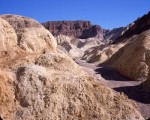 to get the lay of the land (and light) for all the locations. It helps to have a 4 wheel drive as well (we didn’t this time but will next) as many of the great locations to shoot are only accessible on bad roads.
to get the lay of the land (and light) for all the locations. It helps to have a 4 wheel drive as well (we didn’t this time but will next) as many of the great locations to shoot are only accessible on bad roads.
I went a little farther along the hike into Golden Canyon for another shot (provia 100f Rolleidoscope 100th f16). You could spend days walking all the small side trails that take off in all directions in there. Like I said, I will go back to spend more time shooting and getting to more locations with a 4WD.
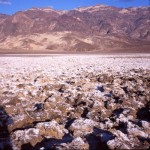 Again in Death Valley. The Devils Golf course is part of an old dry lake bed where the elements have heaved up the soil into hard hollow mounds. The white looks like snow but it’s salt from the ancient salt lake. It’s very difficult to walk on and the salt crystals are sharp so you don’t want to trip and fall! My shadow is there on purpose, to give some idea of the size of the mounds.
Again in Death Valley. The Devils Golf course is part of an old dry lake bed where the elements have heaved up the soil into hard hollow mounds. The white looks like snow but it’s salt from the ancient salt lake. It’s very difficult to walk on and the salt crystals are sharp so you don’t want to trip and fall! My shadow is there on purpose, to give some idea of the size of the mounds.
Provia 100F with a Rolleidoscop 1/100 at f/16
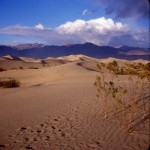 I shot this between sand storms at the sand dunes in central Death Valley last January. The wind had been up for most of the day but settled late in the afternoon for a short time so I managed to get a few shots off before the sand started blowing again. As soon as the wind came up again I had to cram the Rollei into my jacket and walk the 1/2 mile back to the car through blowing sand. If you’ve never been to Death Valley I highly recomend it. It was much more interesting and photogenic than I had imagined and I plan to go back to do more shooting. But avoid the summer as it can get well over 120F out there! It was around 70F while we were there in January.
I shot this between sand storms at the sand dunes in central Death Valley last January. The wind had been up for most of the day but settled late in the afternoon for a short time so I managed to get a few shots off before the sand started blowing again. As soon as the wind came up again I had to cram the Rollei into my jacket and walk the 1/2 mile back to the car through blowing sand. If you’ve never been to Death Valley I highly recomend it. It was much more interesting and photogenic than I had imagined and I plan to go back to do more shooting. But avoid the summer as it can get well over 120F out there! It was around 70F while we were there in January.
Provia 100F shot with my Rolleidoscop 100th f16